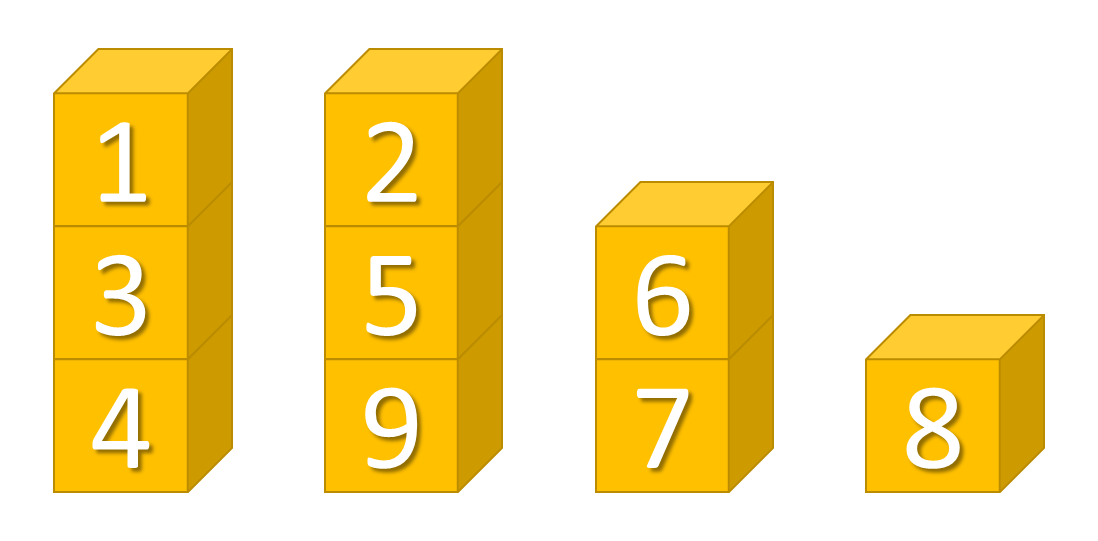A sequence of items can be sorted in increasing order using a technique that is inspired by the Patience card game. Sorting is done in two phases. First, the items are placed one by one in a series of stacks according to these rules:
-
initially there are no stacks
-
the first item forms a new stack that only contains the item
-
each subsequent item $$i$$ is placed on the leftmost stack whose top item is greater than or equal to item $$i$$; if all top items are smaller than item $$i$$, the item forms a new stack to the right of all existing stacks
When there are no more items to be placed, the sorted sequence is recovered by repeatedly picking off the smallest visible item. The visible items are the items on top of the stacks.

For instance, consider sorting the integer sequence (4 3 9 1 5 2 7 8 6) using the Patience sorting technique. The first stack gets 4 and 3. Since 9 is larger than 3, it starts a second stack, 1 goes on the first stack, then 5 and 2 go on the second stack. At this point the first stack (top to bottom) consists of (1 3 4), the second stack consists of (2 5 9), and the remaining sequence consists of the integers (7 8 6). Now 7 goes on a third stack, 8 goes on a fourth stack, and 6 goes on top of the 7 in the third stack. With all the items placed, 1 is collected from the first stack, 2 from the second stack, 3 and 4 from the first stack, 5 from the second stack, 6 and 7 from the third stack, 8 from the fourth stack and 9 from the second stack.
Assignment
An item is represented as an integer (int). A stack of items is represented as a list, where the first element is the item on top of the stack and the last element is the item at the bottom of the stack. A series of stacks that are next to each other is represented as a list, where the first element is the leftmost stack and the last element is the rightmost stack.
Define a class PatienceSorter that can be used to sort a sequence of items in increasing order using the Patience sorting technique. Upon creation of a new object of the class PatienceSorter there isn't any stack of items yet. The class must support at least the following methods:
-
A method stacks that returns the current series of stacks (list).
-
A method stack_count that returns the current number of stacks (int).
-
A method item_count that returns the current number of items in all stacks (int).
-
A method add_item that takes an item. The given item must be placed on top of an existing or new stack according to the rules of the Patience sorting technique. The method must return a reference to the object on which the method was called.
-
A method add_items that takes a sequence (list or a tuple) of items. The given items must be placed one by one on top of an existing or new stack according to the rules of the Patience sorting technique. The method must return a reference to the object on which the method was called.
-
A method remove_item that takes no arguments. If there are no more items the method must raise an AssertionError with the message no more items. Otherwise, the method must remove the smallest visible item from the stacks. If multiple stacks have a smallest visible item on top, the item must be removed from the leftmost of these stacks. If the removed item was the last item in its stack, the stack must be removed from the series of stacks. The method must return the removed item.
-
A method remove_items that takes no arguments. The method must repeatedly remove the smallest visible item from the stacks as in the method remove_item, until there are no more items left. The method must return a tuple containing the removed items in order of removal.
Example
>>> sorter = PatienceSorter()
>>> sorter.stacks()
[]
>>> sorter.stack_count()
0
>>> sorter.add_item(4).stacks()
[[4]]
>>> sorter.stack_count()
1
>>> sorter.add_item(3).stacks()
[[3, 4]]
>>> sorter.add_item(9).stacks()
[[3, 4], [9]]
>>> sorter.stack_count()
2
>>> sorter.add_item(1).stacks()
[[1, 3, 4], [9]]
>>> sorter.add_item(5).stacks()
[[1, 3, 4], [5, 9]]
>>> sorter.add_item(2).stacks()
[[1, 3, 4], [2, 5, 9]]
>>> sorter.add_item(7).stacks()
[[1, 3, 4], [2, 5, 9], [7]]
>>> sorter.stack_count()
3
>>> sorter.add_item(8).stacks()
[[1, 3, 4], [2, 5, 9], [7], [8]]
>>> sorter.add_item(6).stacks()
[[1, 3, 4], [2, 5, 9], [6, 7], [8]]
>>> sorter.stack_count()
4
>>> sorter.item_count()
9
>>> sorter.remove_item()
1
>>> sorter.stacks()
[[3, 4], [2, 5, 9], [6, 7], [8]]
>>> sorter.remove_item()
2
>>> sorter.stacks()
[[3, 4], [5, 9], [6, 7], [8]]
>>> sorter.remove_item()
3
>>> sorter.stacks()
[[4], [5, 9], [6, 7], [8]]
>>> sorter.remove_item()
4
>>> sorter.stacks()
[[5, 9], [6, 7], [8]]
>>> sorter.stack_count()
3
>>> sorter.remove_item()
5
>>> sorter.stacks()
[[9], [6, 7], [8]]
>>> sorter.remove_item()
6
>>> sorter.stacks()
[[9], [7], [8]]
>>> sorter.remove_item()
7
>>> sorter.stacks()
[[9], [8]]
>>> sorter.remove_item()
8
>>> sorter.stacks()
[[9]]
>>> sorter.remove_item()
9
>>> sorter.stacks()
[]
>>> sorter.remove_item()
Traceback (most recent call last):
AssertionError: no more items
>>> sorter = PatienceSorter()
>>> sorter.add_items([7, 5, 2, 1, 8, 6, 3, 9, 4]).stacks()
[[1, 2, 5, 7], [3, 6, 8], [4, 9]]
>>> sorter.stack_count()
3
>>> sorter.item_count()
9
>>> sorter.remove_items()
(1, 2, 3, 4, 5, 6, 7, 8, 9)
>>> sorter.stacks()
[]
>>> sorter.stack_count()
0
>>> sorter.item_count()
0
Resources
-
Burstein A, Lankham I (2006). Combinatorics of patience sorting piles. Séminaire Lotharingien de Combinatoire 54, B54Ab.
-
Chandramouli B, Goldstein J (2014). Patience is a virtue: revisiting merge and sort on modern processors. Proceedings of the 2014 ACM SIGMOD international conference on Management of data, 731–742.
-
Mallows C (1973). Patience sorting. Bulletin of the Institute of Mathematics and its Applications 9, 216–224.